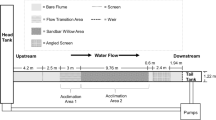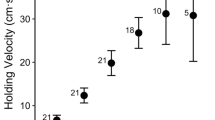Synopsis
Morphology and resource use were compared among recently-emerged brook charr,Salvelinus fontinalis, sampled from field locations differing in current speed. Individuals from faster running water were slightly longer, and had more fusiform body shapes and larger caudal fin heights, than individuals from slower running water. In addition, individuals from faster running water also directed more foraging attempts toward the middle of the water column and fewer toward the benthos and water surface. They also ate more dipteran larvae, fewer aquatic crustaceans, and fewer insect pupae and adults. Individuals located in the slowest and fastest current speeds made fewer foraging attempts per min, on average, than individuals located in current speeds of intermediate magnitude. Dry weight of stomach contents did not vary significantly with current speed, however. The form of the relationship between body shape and current speed suggests that it is adaptive. Small-scale variation in the location of foraging sites may account for some of the individual variability in resource use often reported for stream salmonids. Variation in the locations of foraging sites may also entail a trade-off between an individual's swimming effort and the quality of prey it consumes.
Similar content being viewed by others
References cited
Arnold, S.J. & A.F. Bennett. 1988. Behavioral variation in natural populations. V. Morphological correlates of locomotion in the garter snake (Thamnophis radix). Biol. J. Linn. Soc. 34: 175–190.
Bams, R.A. 1967. Differences in performance of naturally and artificially propagated sockeye salmon migrant fry, as measured with swimming and predation tests. J. Fish. Res. Board Can. 24: 1117–1153.
Bennett, A.F. 1987. Interindividual variability: an underutilized resource. pp. 147–169. In: M.E. Feder, A.F. Bennett, W.W. Burggren & R.B. Huey (eds) New Directions in Ecological Physiology, Cambridge University Press, New York.
Bisson, P.A. K. Sullivan & J.L. Nielson. 1988. Channel hydraulics, habitat use, and body form of juvenile coho salmon, steelhead, and cutthroat trout in streams. Trans. Amer. Fish. Soc. 117: 262–273.
Bulow, F.J. 1987. RNA-DNA ratios as indicators of growth in fish. pp. 45–64. In: R.C. Summerfelt & G.E. Hall (ed.) The Age and Growth of Fish, Iowa University Press, Iowa.
Brett, J.R. 1979. Environmental factors and growth. pp. 599–675. In: W.S. Hoar, D.J. Randall & J.R. Brett (ed.) Fish Physiology, Vol. 8, Bioenergetics and Growth, Academic Press, New York.
Bryan, J.E. 1973. Feeding history, parental stock, and food selection in rainbow trout. Behaviour 45: 123–153.
Bryan, J.E. & P.A. Larkin. 1972. Food specialization by individual trout. J. Fish. Res. Board Can. 29: 1615–1624.
Caswell, H. 1983. Phenotypic plasticity in life-history traits: demographic effects and evolutionary consequences. Amer. Zool. 23: 35–46.
Cummins, K.W. & J.C. Wuycheck. 1971. Caloric equivalents for investigations in ecological energetics. Mitt. int. Ver. theor. angew. Limnol. 18: 1–158.
Cunjak, R.A. 1988. Physiological consequences of overwintering in streams: the cost of acclimation? Can. J. Fish. Aquat. Sci. 45: 443–452.
DeAngelis, D.L., L. Godbout & B.J. Shuter. 1991. An individual-based approach to predicting density-dependent dynamics in smallmouth bass populations. Ecol. Modell. 57: 91–115.
Dill, L.M. 1983. Adaptive flexibility in the foraging behavior of fishes. Can. J. Fish. Aquat. Sci. 40: 398–408.
Ehlinger, T.J. 1990. Habitat choice and phenotype-limited feeding efficiency in bluegill: individual differences and trophic polymorphism. Ecology 71: 886–896.
Elliott, J.M. 1975. Number of meals in a day, maximum weight of food consumed in a day and maximum rate of feeding for brown trout,Salmo trutta L. Freshwater Biol. 5: 287–303.
Fausch, K.D. 1984. Profitable stream positions for salmonids: relating specific growth rate to net energy gain. Can. J. Zool. 62: 441–451.
Fleming, I.A. & M.R. Gross. 1989. Evolution of adult female life history and morphology in a Pacific salmon (Coho:Oncorhynchus kisutch). Evolution 43: 141–157.
Godin, J.-G.J. & R.W. Rangeley. 1989. Living in the fast lane: effects of cost of locomotion on foraging behaviour in juvenile Atlantic salmon. Anim. Behav. 37: 943–954.
Gotceitas, V & J.-G.J. Godin. 1992. Effects of location of food delivery and social status on foraging-site location by juvenile Atlantic salmon. Env. Biol. Fish. 35: 291–300.
Grant, J.W.A. & D.L.G. Noakes. 1987a. Movers and stayers: foraging tactics of young-of-the-year brook charr,Salvelinus fontinalis. J. Anim. Ecol. 56: 1001–1013.
Grant, J.W.A. & D.L.G. Noakes. 1987b. Escape behaviour and use of cover by young-of-the-year brook trout,Salvelinus fontinalis. Can. J. Fish. Aquat. Sci. 44: 1390–1396.
Grant, J.W.A. & D.L.G. Noakes. 1988. Aggressiveness and foraging mode of young-of-the-year brook charr,Salvelinus fontinalis (Pisces, Salmonidae). Behav. Ecol. Sociobiol. 22: 435–445.
Gross, M.R. 1985. Disruptive selection for alternative life histories in salmon. Nature 313: 47–48.
Heggenes, J. & T. Traaen 1988. Downstream migration and critical water velocities in stream channels for fry of four salmonid species. J. Fish Biol. 32: 717–727.
Hosmer, D.W. & S. Lemeshow. 1989. Applied logistic regression. Wiley and Sons, New York. 307 pp.
Hughes, N.F. & L.M. Dill. 1990. Position choice by drift-feeding salmonids: model and test for arctic grayling (Thymallus arcticus) in subarctic mountain streams, interior Alaska. Can. J. Fish. Aquat. Sci. 47: 2039–2048.
Hutchings, J.A. & R.A. Myers. 1988. Mating success of alternative maturation phenotypes in male Atlantic salmon,Salmo salar. Behav. Ecol. Sociobiol. 75: 169–174.
Irvine, J.R. & T.G. Northcote. 1982. Significance of sequential feeding patterns of juvenile rainbow trout in a large lake-fed river. Trans. Amer. Fish. Soc. 111: 446–452.
Jobling, M. 1987. Influences of food particle size and dietary energy content on patterns of gastric evacuation in fish: test of a physiological model of gastric emptying. J. Fish Biol. 30: 299–314.
Kionka, B.C. & J.T. Windell. 1972. Differential movement of digestible and indigestible food fractions in rainbow trout,Salmo gairdneri. Trans. Amer. Fish. Soc. 101: 112–115.
Luecke, C. 1986. Ontogenetic changes in feeding habits of juvenile cutthroat trout. Trans. Amer. Fish. Soc. 115: 703–710.
Mangel, M. & C.W. Clark. 1988. Dynamic modeling in behavioral ecology. Princeton University Press, Princeton. 308 pp.
Manley, B.F.J. 1991. Randomization and Monte Carlo methods in biology. Chapman and Hall, New York. 281 pp.
McCauley, E. 1984. The estimation of the abundance and biomass of zooplankton in samples. pp. 228–265. In: J.A. Downing & F.H. Rigler (ed.) A Manual on Methods for the Assessment of Secondary Productivity in Fresh Waters, Blackwell, Oxford.
McLaughlin, R.L., J.W.A. Grant & D.L. Kramer. 1992. Individual variation and alternative patterns of foraging movements in recently-emerged brook charr (Salvelinus fontinalis). Behaviour 120: 286–301.
McLaughlin, R.L., J.W.A. Grant & D.L. Kramer. 1994. Foraging movements in relation to morphology, water-column use, and diet for recently-emerged brook trout Salvelinus fontinalis) in still-water pools. Can. J. Fish. Aquat. Sci. (in press).
McNicol, R.E., E. Scherer & E.J. Murkin. 1985. Quantitative field investigations of feeding and territorial behavior of young-of-the-year brook charr,Salvelinus fontinalis. Env. Biol. Fish. 12: 219–229.
Meyer, A. 1987. Phenotypic plasticity and heterochrony inCichlasoma managuense (Pisces, Cichlidae) and their implications for speciation in cichlid fishes. Evolution 41: 1357–1369.
Press, S.J. & S. Wilson. 1978. Choosing between logistic regression and discriminant analysis. J. Amer. Statist. Assoc. 73: 699–705.
Puckett, K.J. & L.M. Dill. 1985. The energetics of feeding territoriality in juvenile coho salmon (Oncorhynchus kisutch). Behaviour 92: 97–110.
Riddell, B.E. & W.C. Leggett. 1981. Evidence of an adaptive basis for geographic variation in body morphology and time of downstream migration of juvenile Atlantic salmon (Salmo solar). Can. J. Fish. Aquat. Sci. 38: 308–320.
Ringler, N.H. 1983. Variation in foraging tactics of fishes. pp. 159–171. In D.L.G. Noakes, D.G. Lindquist, G.S. Helfman & J.A. Ward (ed.) Predators and Prey in Fishes. Dr W. Junk Publishers, The Hague.
Ringler, N.H. 1985. Individual and temporal variation in prey switching by brown trout, Salmo trutta. Copeia 1985: 918–926.
Rogers, L.E., R.L. Buschbom & C.R. Watson. 1977. Lengthweight relationships of shrub-steppe invertebrates. Ann. Entomol. Soc. Amer. 70: 51–53.
Rondorf, D.W., G.A. Gray & R.B. Fairley. 1990. Feeding ecology of subyearling Chinook salmon in riverine and reservoir habitats of the Columbia River. Trans. Amer. Fish. Soc. 119: 16–24.
Simonson, T.D. & W.A. Swenson. 1990. Critical stream velocities for young-of-the-year smallmouth bass in relation to habitat use. Trans. Amer. Fish. Soc. 119: 902–909.
Skúlason, S. D.L.G. Noakes & S.S. Snorrason. 1989. Ontogeny of trophic morphology in four sympatric morphs of arctic charrSalvelnius alpinus in Thingvallavatn, Iceland. Biol. J. Linn. Soc. 38: 281–301.
Smock, L.A. 1980. Relationships between body size and biomass of aquatic insects. Freshwater Biol. 10: 375–383.
Strauss, R.E. 1990. Predation and life-history variation inPoecilia reticulata (Cyprinodontiformes: Poeciliidae). Env. Biol. Fish. 27: 121–130.
Statzner, B. 1981. The relation between ‘hydraulic stress’ and microdistribution of benthic macroinvertebrates in a lowland running water system, the Schierenseebrooks (North Germany). Arch. Hydrobiol. 91: 192–218.
Swain, D.P. & L.B. Holtby. 1989. Differences in morphology and behavior between juvenile coho salmon (Oncorhynchus kisutch) rearing in a lake and in its tributary stream. Can. J. Fish. Aquat. Sci. 46: 1406–1414.
Taylor, E.B. & C.J. Foote. 1991. Critical swimming velocities of juvenile sokeye salmon and kokanee, the anadromous and non-anadromous forms ofOneorhynchus nerka (Walbaum). J. Fish Biol. 38: 407–419.
Taylor, E.B. & J.D. McPhail. 1985a. Burst swimming and sizerelated predation in newly emerged coho salmonOncorhynchus kisutch. Trans. Amer. Fish. Soc. 114: 546–551.
Taylor, E.B. & J.D. McPhail. 1985b. Variation in body morphology among British Columbia populations of coho salmon,Oncorhynchus kisutch. Can. J. Fish. Aquat. Sci. 42: 2020–2028.
Taylor, E.B. & J.D. McPhail. 1985c. Variation in burst and prolonged swimming performance among British Columbia populations of coho salmon,Oncorhynchus kisutch. Can. J. Fish. Aquat. Sci. 42: 2029–2033.
Thorpe, J.E. 1989. Developmental variation in salmonid populations. J. Fish. Biol. 35 (Suppl. A) 295–303.
Wainwright, P.C. 1991. Ecomorphology: experimental functional anatomy for ecological problems. Amer. Zool. 31: 680–693.
Ware, D.M. 1978. Bioenergetics of pelagic fish: theoretical changes in swimming speed and ration with body size. J. Fish. Res. Board Can. 35: 220–228.
Webb, P.W. 1984. Body form, locomotion and foraging in aquatic vertebrates. Amer. Zool. 24: 107–120.
Webb, P.W. 1988. Simple physical principles and vertebrate aquatic locomotion. Amer. Zool. 28: 709–725.
Author information
Authors and Affiliations
Rights and permissions
About this article
Cite this article
McLaughlin, R.L., Grant, J.W.A. Morphological and behavioural differences among recently-emerged brook charr,Salvelinus fontinalis, foraging in slow- vs. fast-running water. Environ Biol Fish 39, 289–300 (1994). https://doi.org/10.1007/BF00005130
Received:
Accepted:
Issue Date:
DOI: https://doi.org/10.1007/BF00005130




